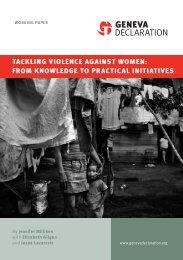Global Burden of Armed Violence - The Geneva Declaration on ...
Global Burden of Armed Violence - The Geneva Declaration on ...
Global Burden of Armed Violence - The Geneva Declaration on ...
You also want an ePaper? Increase the reach of your titles
YUMPU automatically turns print PDFs into web optimized ePapers that Google loves.
130 ti<strong>on</strong>alist claims linking Central American gangs to<br />
migrant trafficking, kidnapping, and internati<strong>on</strong>al<br />
organized crime, it appears that most maras and<br />
pandillas are involved in small-scale localized<br />
crime and delinquency, such as theft and muggings<br />
(Rodgers, 2006).<br />
GLOBAL BURDEN <str<strong>on</strong>g>of</str<strong>on</strong>g> ARMED VIOLENCE<br />
While there is some evidence that certain mara<br />
groups in El Salvador, Guatemala, and H<strong>on</strong>duras<br />
are involved in extorti<strong>on</strong> and racketeering, these<br />
<str<strong>on</strong>g>of</str<strong>on</strong>g>ten extend no further than the territories they<br />
physically c<strong>on</strong>trol. <str<strong>on</strong>g>The</str<strong>on</strong>g>re are, however, growing<br />
risks <str<strong>on</strong>g>of</str<strong>on</strong>g> their assuming a more prominent role in<br />
the drug trade in the coming decade, owing to<br />
the way in which Central America is assuming an<br />
important transit functi<strong>on</strong> in the trafficking <str<strong>on</strong>g>of</str<strong>on</strong>g><br />
narcotics from South America to North America.<br />
Box 7.2 Maras and pandillas in Central America<br />
Maras are organizati<strong>on</strong>s that can be directly linked to specific migratory<br />
patterns. Formerly, there were just two mara groups—the Dieciocho and<br />
the Salvatrucha, which today operate in El Salvador, Guatemala, H<strong>on</strong>duras,<br />
and southern Mexico. <str<strong>on</strong>g>The</str<strong>on</strong>g> gangs find their origins in the gangs <str<strong>on</strong>g>of</str<strong>on</strong>g> Mexican,<br />
Salvadoran, and Guatemalan refugees and migrants in the United States<br />
during the 1960s, 1970s, and 1980s. Following the impositi<strong>on</strong> <str<strong>on</strong>g>of</str<strong>on</strong>g> strict antigang<br />
laws and immigrati<strong>on</strong> reform in the United States, however, many gang<br />
members were repatriated back to Central America. Between 1998 and 2005,<br />
the United States deported almost 46,000 c<strong>on</strong>victs to Central America—<br />
with El Salvador, Guatemala, and H<strong>on</strong>duras receiving more than 90 per cent<br />
<str<strong>on</strong>g>of</str<strong>on</strong>g> the total. <str<strong>on</strong>g>The</str<strong>on</strong>g>se gang members reproduced many <str<strong>on</strong>g>of</str<strong>on</strong>g> the structures and<br />
functi<strong>on</strong>s they exhibited in the United States (Rodgers, 2006).<br />
Pandillas have their origins in the Central American peace processes <str<strong>on</strong>g>of</str<strong>on</strong>g> the<br />
1990s. Demobilized former combatant youths in Nicaragua, El Salvador,<br />
and Guatemala returned home to situati<strong>on</strong>s <str<strong>on</strong>g>of</str<strong>on</strong>g> heightened insecurity and<br />
socio-ec<strong>on</strong>omic uncertainty. Many eventually formed localized vigilantestyle<br />
self-defence groups in an effort to provide safety for themselves and<br />
their families. From relatively organic beginnings, however, they rapidly<br />
expanded and developed semi-ritualized patterns <str<strong>on</strong>g>of</str<strong>on</strong>g> behaviour, including<br />
gang warfare. Some acquired new names—Los Drag<strong>on</strong>es, Los Rampleros,<br />
and Los Comemeuertos in Nicaragua—and assumed strict hierarchies.<br />
Source: Muggah and Stevens<strong>on</strong> (forthcoming)<br />
Extrajudicial killings,<br />
disappearances, and kidnapping<br />
A number <str<strong>on</strong>g>of</str<strong>on</strong>g> forms <str<strong>on</strong>g>of</str<strong>on</strong>g> armed violence perpetrated<br />
by individuals acting in the name <str<strong>on</strong>g>of</str<strong>on</strong>g> the state can<br />
be classified as illegitimate. Two described here<br />
include extrajudicial killings and enforced disappearances.<br />
Owing to their political nature, they<br />
<str<strong>on</strong>g>of</str<strong>on</strong>g>ten remain purposefully hidden from view. It<br />
is, <str<strong>on</strong>g>of</str<strong>on</strong>g> course, important to recognize that not all<br />
uses <str<strong>on</strong>g>of</str<strong>on</strong>g> force are illegitimate. Internati<strong>on</strong>al norms<br />
and, in most cases, domestic laws recognize a<br />
state’s legal m<strong>on</strong>opoly <str<strong>on</strong>g>of</str<strong>on</strong>g> the legitimate use <str<strong>on</strong>g>of</str<strong>on</strong>g><br />
armed force to protect and safeguard citizens,<br />
instituti<strong>on</strong>s, and core values.<br />
But states are also bound by internati<strong>on</strong>al law and<br />
human rights principles, together with nati<strong>on</strong>al<br />
laws, to exercise <strong>on</strong>ly legitimate force. Excessive<br />
or inappropriate uses <str<strong>on</strong>g>of</str<strong>on</strong>g> force can c<strong>on</strong>travene<br />
internati<strong>on</strong>al and domestic laws, and can thus be<br />
declared illegitimate. In certain cases, the illegitimate<br />
use <str<strong>on</strong>g>of</str<strong>on</strong>g> force by public actors against the<br />
populati<strong>on</strong>—ranging from extorti<strong>on</strong> and harassment<br />
to extrajudicial killings and disappearances—<br />
can undermine the legitimacy <str<strong>on</strong>g>of</str<strong>on</strong>g> the state and its<br />
instituti<strong>on</strong>s and generate negative socioec<strong>on</strong>omic<br />
impacts. As a result, many multilateral and bilateral<br />
assistance programmes are seeking to build<br />
effective and accountable security instituti<strong>on</strong>s.<br />
Extrajudicial killings<br />
Human rights groups, such as Amnesty Internati<strong>on</strong>al<br />
and Human Rights Watch or trade uni<strong>on</strong>ists<br />
and local NGOs, have l<strong>on</strong>g decried the use <str<strong>on</strong>g>of</str<strong>on</strong>g><br />
extrajudicial armed violence. Until recently, little<br />
data existed to compare the severity <str<strong>on</strong>g>of</str<strong>on</strong>g> such violence<br />
am<strong>on</strong>g countries and over time. Activists and<br />
others are frequently unable to disclose precise<br />
informati<strong>on</strong> <strong>on</strong> extrajudicial violence for legal and<br />
ethical reas<strong>on</strong>s. Similarly, owing to internati<strong>on</strong>al









